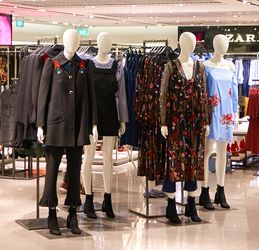There is something going on at Zara. Ever since its store at Mumbai’s Palladium Mall reopened after a redesign a few months ago, it has become unbelievably chic. It has little to do with its newly launched beauty line or its cheap knock-offs of Jo Malone perfumes. Zara is suddenly stylish.
While once fashion lovers would be embarrassed to flaunt their Zara labels, or not wear what was so obviously purchased from the Spanish fast-fashion behemoth, Zara is now back in the black.
The label, a joint venture in India called Inditex Trent between the Spanish owners and the Tata group, has reported a 40 per cent rise in sales here. Zara operates 21 stores across the country with a revenue of Rs2,562 crore in the financial year 2022-23. Moreover, an annual assessment of the apparel business in the UK by Salience Search Marketing reveals that it is the leading retailer from the 300 brands examined (including Marks & Spencer, Primark and Next). Zara led with 91 million social media followers and a sizeable 18,300,000 monthly searches. Apparently, a meme account showing off ‘unusual’ Zara poses has helped in increasing its recognition.
A wedding in Madrid a few months ago of Ricardo Gomez-Acebo Botin (nephew of Santander bank’s Ana Botin) had some guests show up in their favourite homegrown high-street label. The Zara dresses worn here became the subject of an Elle magazine story. The label, once known for its cheap and cheerful party wear, thanks to its knock-off specialist status, was never elevated to occasion wear. But, last year, Selena Gomez wore a blue Zara suit, that cost Euros 150, to Britney Spears’s wedding.
In the first quarter of 2023, Inditex, Zara’s mothership, posted a 13 per cent jump. Its sales for 2022 rose by 17.5 per cent, lifting its market value to Euros 105 billion. This is the highest retail growth of any brand since the pandemic. Much of Zara’s growth is credited to Marta Ortega, the daughter of founder Amancio Ortega, who has launched premium collaborations with American designer Narciso Rodriguez and South Korean label Ader Error. Although Oscar Garcia Maceiras, its current CEO, tells the Financial Times that Zara does not have a new strategy but is only trying to improve quality, style and design.
Zara is obviously trying to hoist its image from being a t-shirt seller like H&M and a copycat (like itself, thanks to owning its own factories and famously aping runway looks in less than three weeks), it’s also a brand that even Kate Middleton would like to wear.
The label is trying hard to move away from its disposable clothing image to adopt a more upscale fashion brand. With much talk around sustainability and transparency, already adopted by H&M, Zara wants to be accepted as a ‘cool’ brand, not just a throwaway. It has also upped its prices by over 30 per cent. When a Zara dress at full price was available for around Rs4,000, it is now sold for Rs6,000.
It is also using less cotton, often called by sustainability followers as the thirstiest plant thanks to its excessive water consumption. Instead, Zara’s new shirts that look and feel like linen are using the chemically produced viscose and synthetic polymers. As a mea culpa, Inditex is rumoured to be considering investing in start-ups that would assist in making it a greener label. However no decision has been made on this as yet.
Is Zara selling old wine in a new bottle? Yes, a bottle of bubbly.
@namratazakaria


